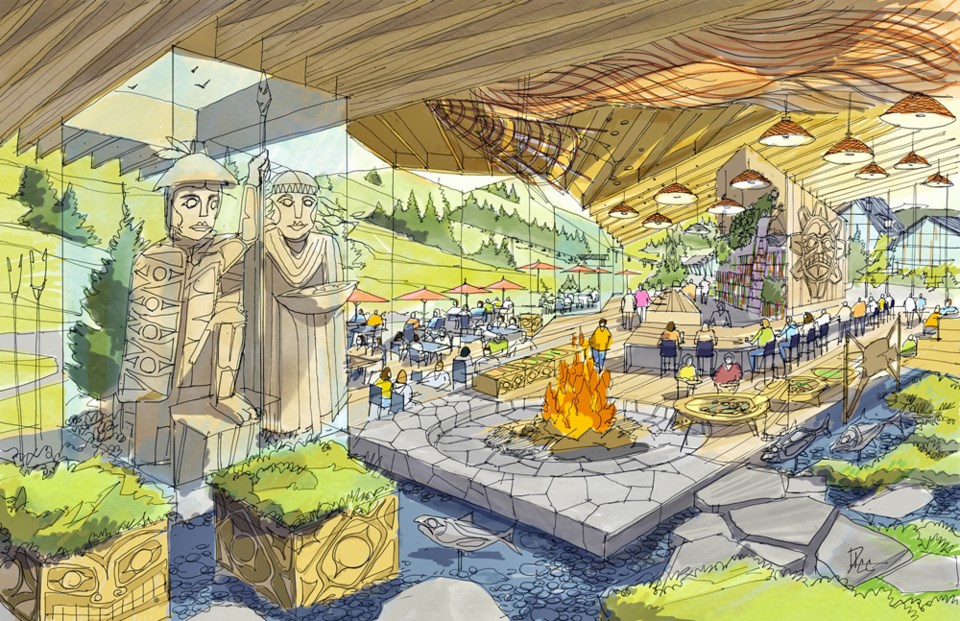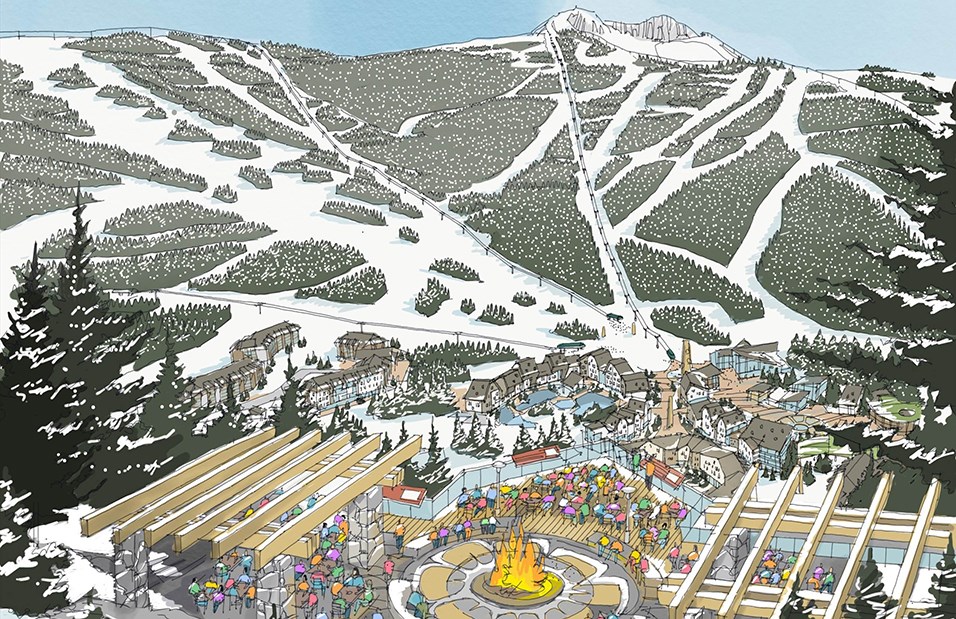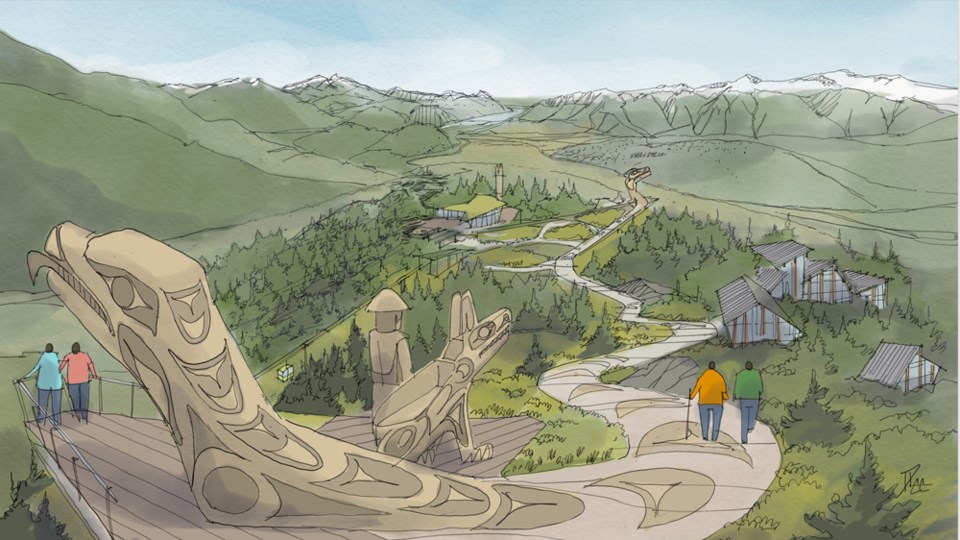While things may seem quiet where the all-season resort Garibaldi at Squamish is concerned, behind the scenes things are moving forward, albeit slowly.
To recap, the resort slated for the Brohm Ridge slopes of Mount Garibaldi will include 130 ski and snowboard trails, 21 lifts, and a network of multi-use trails.
At build-out, the resort could accommodate 15,000 skiers in winter and about 14,000 guests in the summer.
"This would equate to an annual skier visitor count of approximately 995,000, with an average daily demand of 7,000 visitors during the peak winter season and additional visitors during the summer," reads the project's Transportation Concept document.
(These above numbers come from the project's draft Master Plan and are repeated in the document.)
Recent happenings
The project, being developed by Aquilini Development and Northland Properties, applied to the provincial Environmental Assessment Office to extend the Environmental Assessment Certificate that was issued to Garibaldi at Squamish Inc. in January of 2016.
The new application, which was accepted and posted to the EAO website in early July, was to extend the entire certificate by five years.
"Project development has not advanced as quickly as initially planned, due to challenges encountered in attempts by Garibaldi to reach agreement-in-principle with local government before submitting a master plan to the Mountain Resorts Branch of the Ministry of Forests, Lands and Natural Resource Operations," reads the application.
"We gave them a number of drafts and they actually advise changes they want to see," said Sabina FooFat, Garibaldi at Squamish's project director regarding the EAO extension application process.
The project has also asked to amend the timing of requirements of some conditions of the Environmental Assessment Certificate.
"Our request is to remove the specific fixed deadline for these conditions to allow for sufficient time to complete fulsome and thorough on-mountain investigation, before moving to implement the Paradise Valley water system from the Cheakamus Aquifer," reads the EAO application.
FooFat said that the design team is focusing on getting water for the resort from the mountain, rather than from Paradise Valley, an early plan which has been a sore spot for many residents there.
One month after the original EA certificate was issued in 2016, the provincial government introduced the Water Sustainability Act and that act regulates any commercial industrial access to water to ensure that the usage doesn't detrimentally impact the environment, FooFat said.
FooFat said a lot of the work in the EA certificate the project was pursuing overlaps with the Act.
"That is one example of what the EAO will look at to determine if the new legislation impacts the certificate when they extend it."
Three 2016 EA conditions required that the proponents go into Paradise Valley and drill six test wells and confirm the location of the potential main pumping well before January 2021.
"We talked to the EAO office and said we really want to pursue research into on-mountain water, but because the certificate was written so there is a hard deadline for those conditions, we would like to amend the timing."
They are asking that the Paradise Valley requirements not have a deadline at all, as they may not need to do them in the end, she said.
"Say that we are successful in our search for on-mountain water. The EAO condition is written so that we would have to put test wells and drill wells in the Paradise Valley, regardless. And what we are saying is if we don't have to do that work, if we are not withdrawing from the Paradise Valley, we don't want to disturb the Paradise Valley," she said.
"We definitely have a preference to pursue on-mountain water, it makes a lot of sense," she added, but it requires 12 months of data.
Asked why the work hadn't been done in previous years, FooFat said there were plans to drill at the mountain site last winter, but an early snowfall made it impossible.
The on-mountain concept also didn't surface as a possible priority of the project until 2018, she said.
The EAO office is reviewing the applications.
The existing EAO certificate expires in January, so FooFat hopes to hear back from the office regarding the applications by December, she said.
Paradise Valley Community Association
Lawrence Lambrou with the Paradise Valley Community Association, a group which spearheaded the opposition to the resort drawing water from the valley, told The Chief he does believe that the project is moving forward in good faith looking to find on-mountain water.
"And I really do think if they do find water there and it is suitable, it will be a win-win situation," he said.
He added that years ago, when David Negrin was the CEO of Garibaldi at Squamish, Negrin met with a large group of valley residents.
"In that meeting, he actually promised us one thing, he said, "If you don't want us in the valley, ultimately, we will leave,'" Lambrou recalled, adding that while Negrin is not the CEO anymore, the association has reminded the proponents of that promise.
"It was absolutely crucial to moving forward and working together, and, for the most part, we have," he said.
"Getting them to look at alternate [water] sources was absolutely crucial. It has been a long, drawn-out process, but it appears that they are doing that and at the same time, ultimately, if things aren't looking good and the members are really unhappy about the outcome, then there is always that promise to go back on."
District of Squamish
Sea to Sky governments, including the District, have not been particularily supportive of the plan for the resort thus far.
"There are certainly fundamental aspects of this proposal that remain unanswered and are a concern to the District," Mayor Karen Elliott told The Chief in an emailed statement. "However, the District advised the proponent on February 21, 2020, on the required next step of applying for and pursuing a Regional Growth Strategy (RGS) amendment through the Squamish-Lillooet Regional District. We have not been informed that such an application has been made to the SLRD. Should the proponent be successful with an RGS amendment, we will then have a basis for future planning discussions. Our direction on the requirement to pursue the RGS first was conspicuously missing in the proponent's letter to the EAO regarding their extension request."
For the resort's part, FooFat says only the SLRD board or a member municipality of the SLRD can request an amendment to the RGS.
"Garibaldi can’t do this, as we are not a member municipality of the SLRD," she said.
"It is likely that the District of Squamish is well aware that we are not able to apply for an RGS amendment without the District or SLRD leading the amendment process."
In the ministers' decision letter from January 2016, when the EA Certificate was issued, it read:
“We also note that an amendment to the RGS would require unanimous agreement from all member municipalities and adjacent regional districts, including the Resort Municipality of Whistler. If one or more of the SLRD member municipalities and adjacent regional districts choose not to accept the amendment, dispute resolution provisions of the Local Government Act would then apply.”
The project is now working toward the provincial dispute resolution process, FooFat said.

More Squamish Nation input
Recently, there has been more Squamish Nation input in the designs of the Garibaldi at Squamish project, according to FooFat.
In January, the team behind the project met with Squamish Nation's Nch'Kay Economic Development Corporation and showed the design plans.
One of the first comments was that the designs didn't effectively represent Squamish Nation culture and tradition.
"And that was a really fair comment. Those renderings were probably from 2003," FooFat said.
They went back to the drawing board to redo the designs.
"Completing this task was a bit tricky during COVID, but we managed to use online meeting platforms to have a number of working sessions with PWL Landscape Architects, Aquilini's Squamish Nation staff member, and the Squamish Nation Board member to develop a series of illustrations of what the resort could look like as guided by Squamish Nation cultural sharing," FooFat said.
That is how the new images were developed.
"Everything we do at the resort will have to be guided by Squamish Nation. They would have to approve all use of imagery and culture. Our hope is that, when we get the master plan process up and running, we would also do an Indigenous tourism plan with Squamish Nation to ensure that there is cultural appropriateness and respect and protocol for use of culture and language.
The Squamish Nation did not respond to The Chief's request for comment by press deadline.

Mountain Club objections
The Federation of Mountain Clubs of BC, which represents 46 clubs and around 5,300 individual members in the province, told The Chief it remains not in support of the project.
"This level of development will negatively impact non-motorized backcountry winter recreation, summer front country recreation, and devastate the pristine wilderness for which Garibaldi Provincial Park is known," the federation said in a statement.
See the full statement here.
Federation of Mountain Clubs of BC comments by Jennifer Thuncher on Scribd
Transportation
Condition 11 of the Garibaldi at Squamish EA Certificate is that the project must prepare a Transportation Plan to be approved by the Ministry of Transportation and Infrastructure.
The 2014 Traffic Assessment assumed that near Depot Road, traffic at peak times would increase by 25% to 50%. South of Squamish, it was expected to add 12% to 17% overall to daily traffic and 15% to 25% to peak-hour traffic by project build-out.
The ultimate Garibaldi at Squamish plan for traffic aims to reduce that impact.
"The first step in developing a plan is to understand the transportation vision, goals and priorities for the resort, and to develop these we retained Fehr and Peers Transportation Consultants," FooFat said about the July 2020-published Transportation Concept.
The goals are outlined in the introduction of the document.
"The transportation strategies outlined in this Transportation Concept are intended to create a resort environment that is forward-looking, ecologically minded, and highly accessible. The Garibaldi Resort will generate additional travel demand along the Sea-to-Sky Highway. Many strategies considered in this Transportation Concept balance reducing traffic impacts with the goal of ensuring that the resort is simultaneously accessible and environmentally responsible."
For opening day, the vision is for visitors to ride private buses to and from a central hub within the resort and that those who opt to drive will be able to park once and use active transportation, including electric micro-transit and electric buses to get around.
Later, the idea is for a robust bus service to and from the resort. Visitors could be able to park in the Lower Mainland and ride to the resort or to a gondola to get to it.
Longer-term, the vision is that visitors will have rail, bus, and ferry services with central hubs in the Lower Mainland.
But this would require the Ministry of Transportation to get on board with regional transportation in the corridor.
"The District of Squamish has a large commuter population... and so likewise, even though Squamish is a growing community, in the OCP I didn't find a clear requirement for a regional transportation plan," she said.
FooFat said that the project did reach out and have conversations with the Ministry of Transportation, but those talks didn't get far in terms of a solution for traffic in the corridor, she said.
"It is not evident to me that there is a lever to change the status quo," she said.
"The Ministry, when we spoke to them, is aware of our EAO requirement for a transportation plan, but they are also aware of the fact that transportation on the highway has its peak congestion nightmares — I think we can call them — and the resort will generate more traffic, but the resort isn't the sole generator of traffic," she said.
What really needs to happen is a regional solution, FooFat said.
"I would love for the resort to be a catalyst to really make effective regional solutions happen... Ultimately, a holistic solution is the better one."
Q&A with Ministry of Transportation
The Chief asked the Ministry of Transportation and Infrastructure questions in relation to the project and regional transit. Here's an edited version of that exchange.
Q: What role does the ministry have, if it sees it has a role, in ensuring a sustainable regional transit system that can keep up with the increase the Garibaldi at Squamish resort will bring (that will coincide with increased traffic from the Whistler Blackcomb expansion and other projects, such as the Sea to Sky Gondola, Woodfibre LNG etc.)?
A: The province partners with local governments to provide BC Transit services in over 130 communities serving 1.8 million people.
In 2020/21, the province is projecting to spend $116 million for its share of transit (the Provincial share depends on the type of service, but on average, the province contributes approximately 50% toward the cost of transit.)
British Columbia is the only province in Canada that supports regional transit with this kind of cost-share model.
Our priority is to ensure that transit is affordable for people across B.C., and also to support BC Transit in delivering reliable and safe service to passengers.
Where new industries or tourist attractions are established which would benefit from public transportation, the local government works with the private company and BC Transit to determine what service is required.
The Sea to Sky Gondola is a good example of a co-operative arrangement to provide transportation from Squamish to the Gondola.
The District of Squamish had an agreement with the Sea to Sky Gondola and BC Transit.
The BC Transit service provided transportation for employees while also making more parking available for visitors.
Q: By the time the project is built out, is there a Ministry vision for rail — robust regional transit for example? Or is this transportation plan to accommodate increased traffic placed entirely onto the resort itself?
A: This vision belongs to the region, not the B.C. government.
The Government of B.C.’s priority is to ensure that transit is affordable for people across B.C., and also to support BC Transit in delivering reliable and safe service to passengers.
Where new industries or tourist attractions are established, the local government works with the private company and BC Transit to determine what level of transit service, if any, is required.
Q: Where does the bus regional transit plan for the Sea to Sky stand currently? Last year, we were told the stakeholders — which include District of Squamish, Pemberton the Resort Municipality of Whistler, and Lil'wat and Squamish nations — put forward a proposal at the end of 2018, but that the province had not responded to it with a funding model?
A: An ideal collaborative funding solution between the local partners and the province has not emerged.
The local partners have advocated for a regional motor fuel tax to fund their share of the cost of a regional transit service.
As a regional motor fuel tax has not been approved, the local share of funding is not in place, and consequently there was no expansion funding allocated for Sea to Sky regional transit in 2020/21 as part of Budget 2020.
Next steps for Garibaldi at Squamish
FooFat said that working with the Squamish Nation is the highest priority currently.
"That the resort is what they want to see," she said.
There are also other conditions to meet.
"Only some of them are pre-construction, but they include things like the biology retention-ecology management plan and so that is the wildlife, flora, and fauna management plan," she said, adding that consultants are working on that plan and it is nearing the first-draft stage.
That work will continue in the fall and include consultation with, in addition to the Nation, other agencies.
The on-mountain water research continues, too.
Mapping of wells, a round of which was completed by contractors in July, found two "very promising" well locations in the main village area.
"So we are going to need to mobilize — ideally, to get up and drill those wells before the snow falls again. As well, we want to get surface flow monitoring underway again."
Right now, there is one surface flow monitor high up on the site on a tributary of the Brohm River, more flow monitoring for additional water courses on the mountain are required.
"That is to establish your surface flow baselines," she said.
"So you have your surface flow baselines throughout the year and then you have test wells and you do a number of pump tests on those wells to draw down water and the goal is to monitor if there is any impact to surface flow."
Squamish Nation has identified that it is really important to them that the environment isn't impacted by wells and well drilling so that is work that the project hopes to roll out in the next three months.
Also, updates to the Master Plan are underway, including the sustainability section to ensure it is as environmentally-friendly as it can be.
"It has been a lot of work, but really, really good work," she said.
**Please note, this story was modified after it was first posted to add that the numbers in paragraphs three and four came from the project's draft Master Plan originally and to correct a typo in a FooFat quote about "on-mountain" water. Originally, it incorrectly said "on-water."



